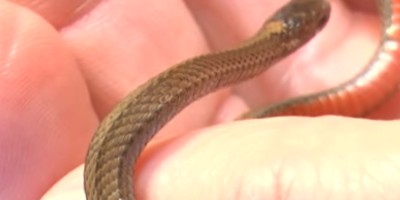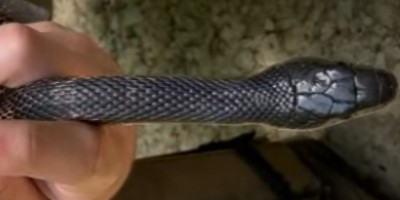
Welcome to bridgeportsnakes.com! I am David, a snake enthusiast living in Bridgeport, CT. Many people don't know that Bridgeport is in fact full of snakes! You just need to know where to find them - they can often be shy and elusive. Some Connecticut snake species are more common outside of the city limits, in different parts of Fairfield County CT, but many types of snakes are indeed common in the more urban parts of Bridgeport. This guide is meant to help educate you about the beautiful snakes of Bridgeport, and to help you identify the most common snakes of Bridgeport, as well as the venomous snakes of Bridgeport that you should learn to recognize and avoid. If you want more detail, click here for my complete list of ALL snake species in Bridgeport. Remember the following:
- Most snakes of Bridgeport are harmless and don't want to encounter you
- Venomous snakes exist but are uncommon in Bridgeport, Connecticut
- Snakes eat rats and mice and are a valuable part of the Connecticut ecosystem
- Never kill a snake - if you leave a snake alone, it will leave you alone.
Common Snake Species in Bridgeport
 Smooth green snake:
This colorful snake may be found in almost all regions of Connecticut. Adults can grow up to 22 to 26 inches in length. The skin of the snake is bright green with a yellowish or white underside. Smooth green snakes are most often found in moist habitats. They live around savannahs, marshes, lakes, and forest edges. They may also occasionally share burrows with other smaller snakes during hibernation. In the wild, smooth green snakes feed on grasshoppers, spiders, caterpillars, and so on. They are non-venomous and not harmful to humans and pets. Smooth green snakes are very docile and will rarely bite.
Smooth green snake:
This colorful snake may be found in almost all regions of Connecticut. Adults can grow up to 22 to 26 inches in length. The skin of the snake is bright green with a yellowish or white underside. Smooth green snakes are most often found in moist habitats. They live around savannahs, marshes, lakes, and forest edges. They may also occasionally share burrows with other smaller snakes during hibernation. In the wild, smooth green snakes feed on grasshoppers, spiders, caterpillars, and so on. They are non-venomous and not harmful to humans and pets. Smooth green snakes are very docile and will rarely bite.  Red-bellied snake:
The red-bellied snake is a small-sized snake that grows to a maximum length of 16 inches. The skin is grey, black, or brown with two dark stripes running down the back and sides. The snake may have some light spots on its neck which may form a temporary ring. The belly may be red, orange, or pink colored. At the base of the neck, there are usually 3 spots which may be orange or yellowish in color. The snake has rough scales. The red-bellied snake is found in woodlands, forest edges, meadows, and fields. They may hide out under logs, rocks, or even foundations although they aren't likely to be seen where there isn't an abundance of forests. Their diet consists mainly of small animals such as slugs, snails, earthworms, and so on. The red-bellied snake is non-venomous but it is perfect at camouflaging. When threatened, it may curl up its upper lip to make itself appear more dangerous. It may also flatten its body and emit a foul-smelling musk to ward off intruders.
Red-bellied snake:
The red-bellied snake is a small-sized snake that grows to a maximum length of 16 inches. The skin is grey, black, or brown with two dark stripes running down the back and sides. The snake may have some light spots on its neck which may form a temporary ring. The belly may be red, orange, or pink colored. At the base of the neck, there are usually 3 spots which may be orange or yellowish in color. The snake has rough scales. The red-bellied snake is found in woodlands, forest edges, meadows, and fields. They may hide out under logs, rocks, or even foundations although they aren't likely to be seen where there isn't an abundance of forests. Their diet consists mainly of small animals such as slugs, snails, earthworms, and so on. The red-bellied snake is non-venomous but it is perfect at camouflaging. When threatened, it may curl up its upper lip to make itself appear more dangerous. It may also flatten its body and emit a foul-smelling musk to ward off intruders.
 Eastern rat snake:
The eastern rat snake, much like other rat snakes, can grow very large, with adults typically reaching anywhere from 3 - 5 ft. Adults are yellowish or yellowish-grey. Their backs are marked with stripes and may also have blotches sometimes. The juveniles are marked with grey to black blotches which fade gradually as they develop into adulthood.Eastern rat snakes are abundant in forested areas and can be found in pine forests, swamp edges, hardwood forests, and marshes. They are also quite adapted to living in the suburbs and hide out in abandoned buildings and barns. They are excellent climbers. The eastern rat snake survives on insects, frogs, snails, birds and their eggs, mice, rabbits, and so on. They are constrictors that use their bodies to suffocate prey before swallowing it. The eastern rat snake is non-venomous and poses no threat to humans or pets. When threatened, the eastern rat snake releases a foul-smelling musk to ward off intruders.
Eastern rat snake:
The eastern rat snake, much like other rat snakes, can grow very large, with adults typically reaching anywhere from 3 - 5 ft. Adults are yellowish or yellowish-grey. Their backs are marked with stripes and may also have blotches sometimes. The juveniles are marked with grey to black blotches which fade gradually as they develop into adulthood.Eastern rat snakes are abundant in forested areas and can be found in pine forests, swamp edges, hardwood forests, and marshes. They are also quite adapted to living in the suburbs and hide out in abandoned buildings and barns. They are excellent climbers. The eastern rat snake survives on insects, frogs, snails, birds and their eggs, mice, rabbits, and so on. They are constrictors that use their bodies to suffocate prey before swallowing it. The eastern rat snake is non-venomous and poses no threat to humans or pets. When threatened, the eastern rat snake releases a foul-smelling musk to ward off intruders.
Venomous Snake Species in Bridgeport
 Timber rattlesnake:
Also known in some areas as the canebrake rattlesnake, the timber rattlesnake is a heavy-bodied snake that may measure on average 36 to 60 inches in length. Its skin is usually greyish or black to yellowish pink. Adults have crossbands arranged down the length of the body. There may be a red stripe running in between the crossbands in many individuals. Timber rattlesnakes may live on hillsides and lowlands alike. They are found in hardwood forests, pine flatwoods, and cane thickets. Their diets mostly consist of mice, squirrels and occasionally, they may eat birds and frogs. Just like all pit vipers, the timber rattlesnake is venomous and a bite may be fatal to humans and pets. They have long fangs that can penetrate into clothing. Bites from timber rattlesnakes are, however, quite rare as they are not aggressive. They will rattle their tails when disturbed in an attempt to warn intruders before they strike.
Timber rattlesnake:
Also known in some areas as the canebrake rattlesnake, the timber rattlesnake is a heavy-bodied snake that may measure on average 36 to 60 inches in length. Its skin is usually greyish or black to yellowish pink. Adults have crossbands arranged down the length of the body. There may be a red stripe running in between the crossbands in many individuals. Timber rattlesnakes may live on hillsides and lowlands alike. They are found in hardwood forests, pine flatwoods, and cane thickets. Their diets mostly consist of mice, squirrels and occasionally, they may eat birds and frogs. Just like all pit vipers, the timber rattlesnake is venomous and a bite may be fatal to humans and pets. They have long fangs that can penetrate into clothing. Bites from timber rattlesnakes are, however, quite rare as they are not aggressive. They will rattle their tails when disturbed in an attempt to warn intruders before they strike.
 Northern copperhead:
The northern copperhead is a colorful, medium-sized snake. Adults can grow between 24 and 36 inches in length. Its head is copper-colored and its body has a reddish tan. Its back is marked with dark crossbands that form an hourglass shape. A pit used in heat sensing is located on its head just between the eyes and nostrils. Northern copperheads are very much adaptive and can be found in just about any habitat. They do well in the wilderness as well as suburban and even urban areas. They can also reside on hillsides or swampy areas. Fishes, amphibians, insects, and smaller snakes make up their diet. They are ambush predators and they may lie in a spot for a long time waiting for prey. The pit on their heads allows them to detect when prey is nearby. They inject the prey with their venom before swallowing it. Copperheads are venomous and they pose a threat to humans and pets. They are however very sluggish snakes and rely on camouflage to get away from predators. Unlike rattlesnakes, Northern copperheads do not give warning signals and they may strike once startled.
Northern copperhead:
The northern copperhead is a colorful, medium-sized snake. Adults can grow between 24 and 36 inches in length. Its head is copper-colored and its body has a reddish tan. Its back is marked with dark crossbands that form an hourglass shape. A pit used in heat sensing is located on its head just between the eyes and nostrils. Northern copperheads are very much adaptive and can be found in just about any habitat. They do well in the wilderness as well as suburban and even urban areas. They can also reside on hillsides or swampy areas. Fishes, amphibians, insects, and smaller snakes make up their diet. They are ambush predators and they may lie in a spot for a long time waiting for prey. The pit on their heads allows them to detect when prey is nearby. They inject the prey with their venom before swallowing it. Copperheads are venomous and they pose a threat to humans and pets. They are however very sluggish snakes and rely on camouflage to get away from predators. Unlike rattlesnakes, Northern copperheads do not give warning signals and they may strike once startled.
If you're unsure, you can email me a photo of the snake at info@bridgeportsnakes.com and I will email you back with the snake's species. If you found a snake skin, read my Found a Skin? page, and you can email me a photo of the skin, and I'll identify the snake for you. If you need professional Bridgeport snake removal help, click my Get Help page, or see the below website sponsor I found, who provides that service.
Remember, the term is not poisonous snakes of Bridgeport, it's venomous snakes of Bridgeport. Poison is generally something you eat, and venom is injected into you. That said, dangerous snakes are very rare in Bridgeport. The few venomous snakes of Fairfield County are rarely seen. But they are commonly misidentified, so learn about all the snake species of Bridgeport in order to correctly identify them. These snakes are usually also found in the surrounding towns of Bridgeport, Norwalk, Stamford, Greenwich, Westport, Danbury, New Fairfield, Shelton, New Canaan, Trumbull, Darien, Ridgefield, Wilton, Stratford, Newtown, Weston, Bethel, Brookfield, Monroe, Easton, Sherman, Redding, and the surrounding areas.
Read our article about:
Legalities on Keeping and Catching Venomous Snakes
bridgeportsnakes.com domain and hosting costs made possible by the generous support of this sponsor:
